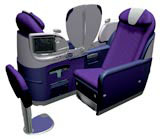BA turns things around
If you fly business class, comfort is crucial. BA has completed the pre-flight checks on a new seat, designed by Tangerine. But will the seat revive BA’s fortunes?

Not since the Battle of Britain has an air war garnered so much publicity. But the conflict currently being waged in the skies is a non-violent one, and the victors will take cash, not countries.
The airline sector has seen an enormous shake-up in recent years. The no-frills approach of EasyJet has highlighted the tall profit margins enjoyed by more established operators, tapping into consumer concerns about “rip-off Britain”, and spawning a host of cut-price imitators.
Full-price airlines now have little choice, if they are to continue charging premium rates, than to offer ever higher standards. British Airways is hoping that its trump card, the world’s first fully flat bed in business class, will give it the advantage it craves.
The airline describes its £200m Club World revamp project as a bid to create a “lounge in the sky”, part of its strategy to focus on the most profitable sectors of the travel market. Customer research showed that business class travellers want as many perks as possible, with decent sleep, privacy, space and flexibility top of the list.
The result is a reclining seat, which folds to a fully flat position, improved entertainment and communication facilities, and better catering. Other changes – to First Class interiors – and the introduction of a new fare level above budget but below Club Class, have been overshadowed by what appears to be a modern incarnation of the traditional love seat.
BA will be making as much noise as possible about the extra space and comfort available in its new mile-high club. The seat has a pitch of 185cm, which it claims is 33cm greater than its nearest competitor.
Behind the launch of the new seat is an intensive 18-month project by London product design group Tangerine. The consultancy has created a seat designed to be arranged in forward and rearward facing pairs for a number of reasons: as well as enabling more chairs to fit into each aircraft, the design allows each passenger more privacy by using a wraparound panel between the seats.
Entertainment systems are built in, and an independent hinged footstool which forms the end of the bed allows for increased flexibility in terms of comfort and posture. There are the usual built-in spaces for everything, from lifejackets to in-flight magazines.
Designing aircraft seats is a complicated business. Tangerine was bound by strict international safety rules governing what materials may be used, down to stipulations regarding the thickness of upholstery. Weight was a major issue, meaning an aluminium seat frame is used and just one motor copes with all of the electrical adjustments for each seat.
Servicing is a major factor, too. An airline cannot afford to have aircraft inoperable while small components are replaced so all the elements of the seat – such as the electric motor and entertainment system – have to be quick and easy to replace while a plane is being refuelled.
The finished design also has to be subjected to the feared 16G test, which replicates the G-force created by sudden manoeuvres or impact. To put this into context, jet fighter pilots are expected to lose consciousness at somewhere over 7G, unless protected by a special suit which can increase their tolerance to around 9.5G.
“Two things set the project apart,” says Tangerine founding partner Martin Darbyshire. “First, BA let Tangerine take a blue sky approach to the project, with no constraints on the structure of the seat. Second, BA allowed us to set up and lead a team so that the design work was managed in the most effective way.” In setting this team up, the consultancy worked with specialist companies in human factors and modelling, as well as design group FutureBrand. All groups worked closely with BA’s in-house design management team.
Tangerine’s brief was to develop a “redefinition of business travel that would astound”. According to senior designer Matt Round, the key to the final design was to humanise the experience and add a level of lounging. “At home you don’t stop to think how your sofa is constructed or search for your TV beneath it. Our aim was to introduce a lounge-like feel to the cabin, where technology was discrete from furniture and each passenger could adapt the space to suit their mood.”
The travelling community of executives who will be the key users has yet to respond to the new design for the seat.
Darbyshire concedes that some travellers could be put off by the idea of facing backwards while flying, especially during take-off and landing, but says the experience barely differs from facing the other way. BA is likely to offer travellers the choice of which way they face, and as rear-facing passengers get the added benefit of a window in their private cubby hole it may prove the more popular choice. Military aircraft often have rear-facing seats, considered less likely to cause spinal injuries in the event of a forced landing.
And the novelty value could well lead to some bookings in itself. Though they are likely to be made with company credit cards.
BA check-in
– Interior designer Kelly Hoppen has developed interiors for British Airways First service.
– Conran & Partners is developing new interiors for BA’s Concorde fleet, in association with Factory Design.
– Tangerine has developed the new Club World seat, with FutureBrand advising on the internal colour scheme and fabrics.The group has also worked with human factors consultant Davis Associates and modelling group Drive Inc on the project.
-
Post a comment



